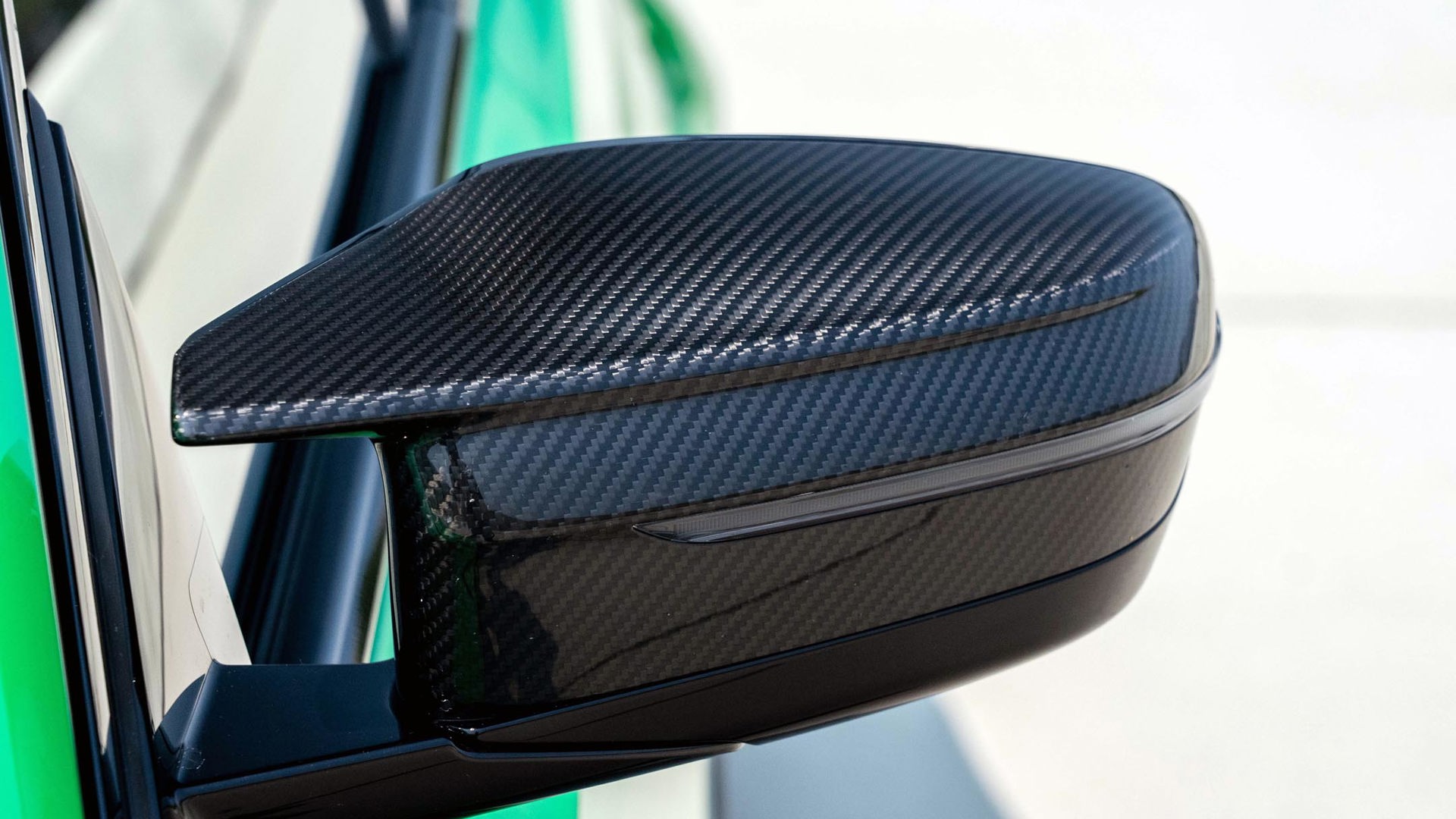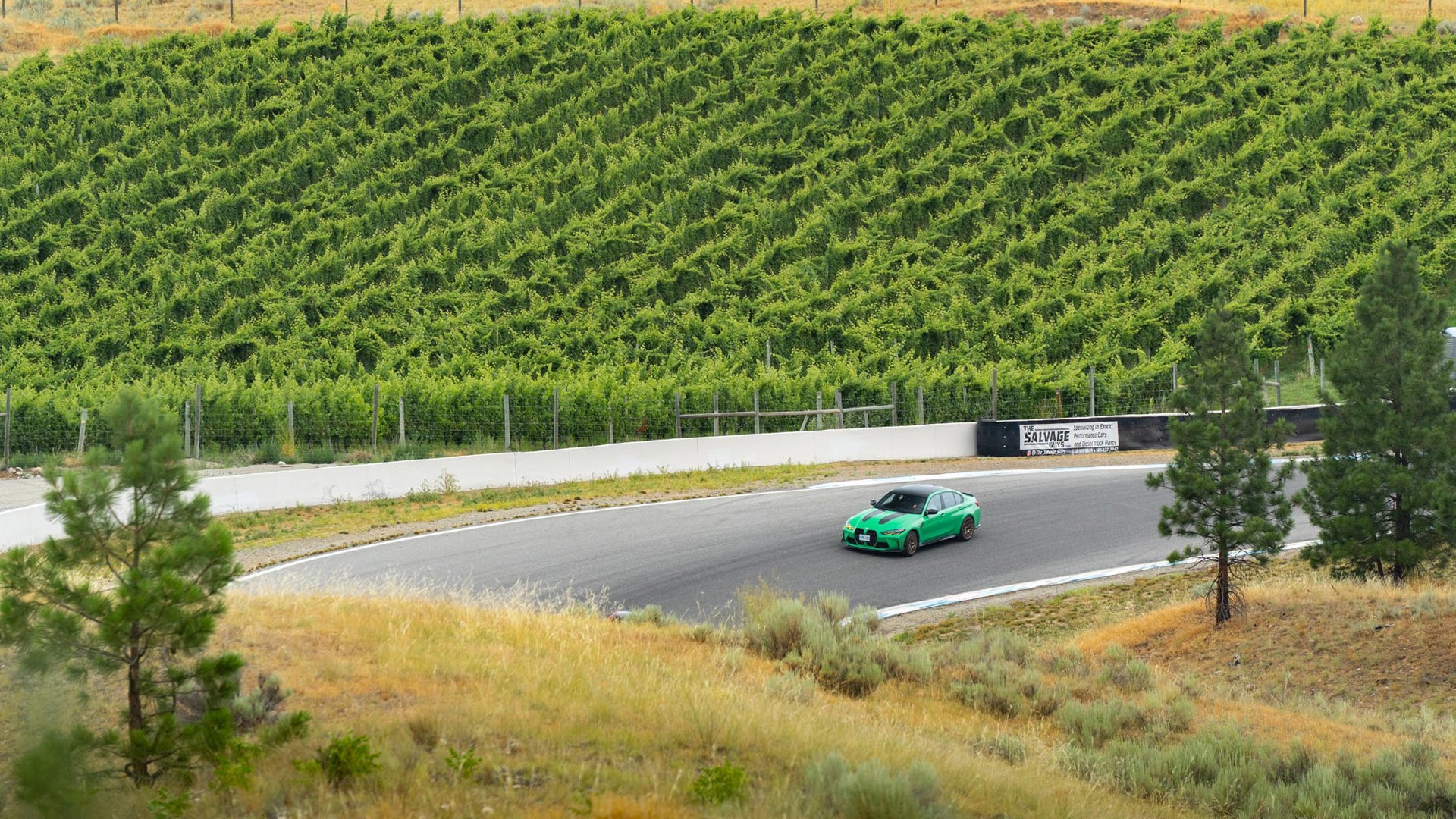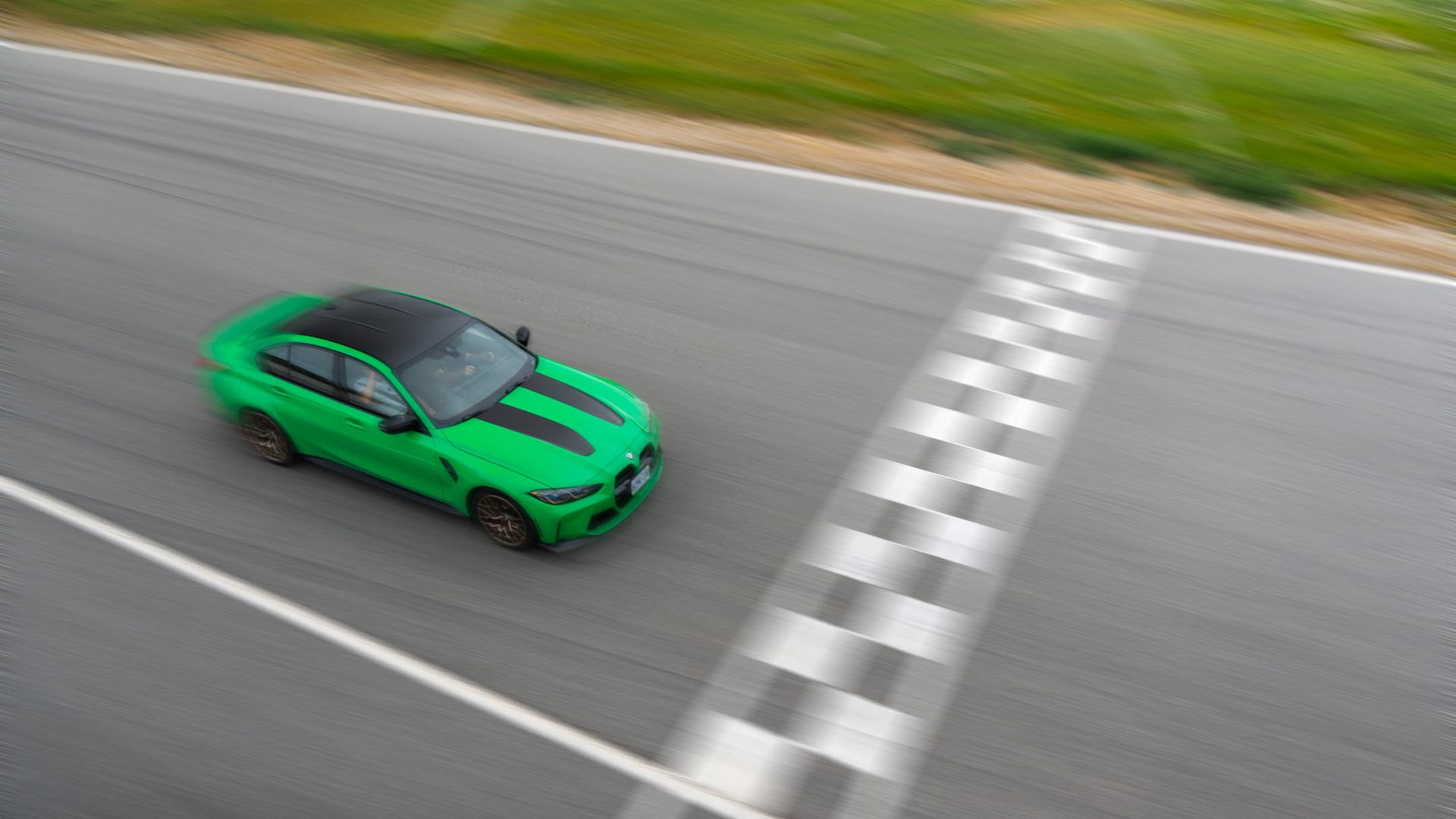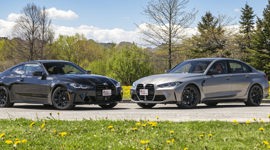Photos: Brendan McAleer, BMW
The current M2 is rightly held up as favourite amongst BMW purists – the smallest and nimblest of them all.
From the driver’s seat on a hot lap of a demanding and technical racetrack, it’s both a joy and a challenge, balanced and grippy, easy to rotate, with a turbocharged straight six-cylinder doling out ferocious power. But then you get into the 2024 BMW M3 CS and it makes the mighty M2 feel like you’ve been driving around with the handbrake on.
What Is It?

The 2024 BMW M3 CS is the quickest, lightest, and most track-focused variant of the 3 Series on sale today. At $148,000 to start, it’s both eye-wateringly expensive and exclusive, with BMW planning to sell just 1,000 examples – globally. The gaping twin-kidney grille of the regular 3 Series already look like roadkill TIE fighter, but here an overwrought aggression is doubled-, no, tripled-down on with twin stripes and carbon-fibre exterior aerodynamics. The interior is perhaps even more insane.
The only thing more hardcore in BMW’s lineup is (arguably) the lighter M4 CSL. However, that particular car is an impractical coupe, whereas the M3 CS has four doors, all-wheel-drive, and a space in the trunk for a stroller – assuming your child is the reincarnated spirit of famed BMW racing driver Hans-Joachim Stuck. Which would be a heck of a trick, because Hans isn’t actually dead yet.
This thing makes the absolute minimum amount of sense, but it’s such a complete monster that reasonable thinking gets left in the dust along with the M2 and pretty much everything else. This is BMW M-for-Monster, and in a racetrack setting at least, it’s utter over-the-top magic.
I’m Sorry, How Much?

No, I didn’t think we were going to just scroll past that gut-punching price tag. BMW’s standard 473-hp M3 costs $89,500 for a rear-wheel-drive version with a manual transmission, and that’s before packages. The M3 Competition adds an eight-speed automatic and all-wheel drive, and bumps output to 503 hp. It costs $96,400 before options, freight, and taxes.
The M3 CS is 50 per cent more expensive for eight per cent more horsepower. That’s quite the premium, especially considering the 40-hp bump comes from little more than a retune and added boost. However, at least the CS comes with a host of other upgrades that will make it a great deal less comfortable.
Stiffer motor mounts mean the 3.0L inline-six engine transmits vibrations more directly to the cabin, and specifically to the extremely rigid standard M carbon bucket seats. There’s also comprehensive use of carbon-fibre from the hood to the roof and most of the aerodynamic pieces. The rear exhaust silencer is titanium. Total weight savings are claimed at 20 kg (44 lb), or about what Hans Jr.’s car seat will add back once you strap it in.
Not the M3’s First High-Priced Rodeo
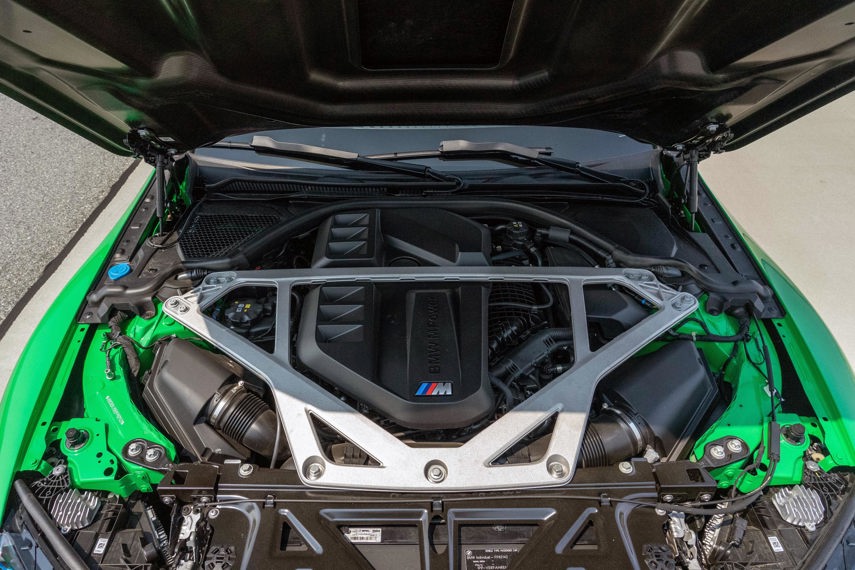
To briefly touch on the M2 again, there’s a reason that most M fans picture a stubby coupe when asked what the soul of the brand is built on. The original E30 M3 of the 1980s was a buzzy, box-flared delight, built as a road car only to satisfy certain racing regulations that required road-going versions of the cars BMW wanted to race. In the industry, these are referred to as homologation specials, and you don’t really see them around much any more.
A big reason why is that the original M3 was something of a financial disaster. They’re worth big money today, but in-period, few buyers wanted to pay a premium for less weight and a fizzy four-cylinder – not when the 325is was right there with a more polished experience for far less money.
Thus, when BMW brought the next-generation M3 to this side of the Atlantic, it slightly detuned the inline-six engine, opting for lower cost and slightly better serviceability. The plan worked, and something similar happened for the third-generation car. While the European market got some extremely pricey special edition lightweight models, BMW didn’t think it could justify them here. So, forbidden fruit they remained.
Even if the M3 CS is the exact opposite of value-priced, it does at least reflect BMW’s confidence in the Canadian (and North American) market. Canadians buy a lot of M cars, and even if most of them are of the SUV variety, the niche demand for a hardcore performance sedan is clearly there. Even the argument that the M3 CS is straying into M5 territory falls a bit flat; even if the current 3 Series is sized like its bigger sibling was back in the day, the M5 has always been a fast executive-class sedan. The M3 CS is not for tailored business apparel. It’s for Nomex racing suits.
Expect Some Swearing

On the street, an M3 Competition is already more car than you could possibly use; and you probably want the automatic transmission and clever all-wheel drive system to get the power down. On a racetrack, however, subtle differences are amplified. Not that the M3 CS needs any amplification. It’s bonkers quick.
Right out of pitlane, things feel as though they’re on fast-forward. BMW claims a zero-to-100 km/h time of 3.4 seconds, but it also suggested the M5 would produce similar times and test results were often a half-second quicker or better. On a cool morning, the tarmac just dried from overnight rain, the M3 CS hauls hard for the first corner like a charging Visigoth.
A first lap requires a mental readjustment compared to the other M products on track, as the limits are so much higher. Even on the same Michelin Pilot Sport Cup 2 tires as the M2, the M3 CS manages to brake later, pour on the power earlier (thanks to the extra gip of BMW’s rear-biased all-wheel-drive), and easily touches 220 km/h on the first straight before needing to brake for a sharp left-hander.
And don’t brake too hard, because the M3 can carry far more speed than would reasonably be expected. Confidence here is massive, especially given the huge level of adjustability BMW provides in terms of traction control settings and mapping for throttle response, suspension stiffness, and so on. There’s plenty to nerd out on here, but the most reliable way to learn the track was with most settings in their sharpest mode apart from throttle response. Smooth inputs make for a relatively quick pace. Manually shifting the conventional automatic transmission (with carbon-fibre paddles in the CS) is basically optional as the transmission is very nearly as quick as a dual-clutch gearbox would be.

Further, the M3 is absolutely one of those hero cars that flatter the ego. Porsche is expert at providing an invisible electronic safety net for track work, and BMW’s M division has managed it here as well. Finding the limit isn’t about exploring a knife edge, but about feeling the car compensating for what you got wrong, then adjusting the approach next lap. The experience is centred around the way the turbocharged engine just hurls the car down the track, but there’s communication to go along with sheer grip. Speeds are immense, yet it all feels so secure.
Again, punting a car this expensive off-track is not a desirable experience. You can duct-tape a track rat 1990s M3 back together without feeling bad, but there are no trophies handed out at track days for street cars like the M3 CS. Rather, this thing will let you chase your well-heeled friends in their 911s or Huracáns all day, then also be able to ferry three of them to that evening’s dinner.
On track, the fact that the M3 CS is still, at heart, a roomy four-door sedan doesn’t swim into your thoughts once. It’s too fast, too satisfying, and feels built without compromise. Enough feedback is here to let the car’s sheer pace fade into the background and just work on fine-tuning a set of challenging turns.
BMW fields M3s in GT3 racing, but the M3 CS is not quite a race car for the road. Rather, it’s just a dialled-in version of an already incredibly competent chassis, optimized for the only place you can actually unlock its potential.
Final Thoughts

Rather than merely a faster version of an already quick car, the 2024 BMW M3 CS comes with a warning. It’s not a purist’s special, but the damn-the-torpedoes most extreme version of the M3 yet. By the numbers, it’s far too expensive for the improvements gained. In a racing car, spending tens of thousands of dollars to shave off tenths of a second on a lap time is what the game is all about. With a road car, it just looks like excess. Save your money and buy a lesser model instead; 92 per cent of the performance and satisfaction for 66 per cent of the price tag.
That’s not the cautionary part, though. The warning is this: if you’re considering buying an M2 or an M3 Competition, under no circumstances get behind the wheel of an M3 CS. Especially if offered a hot lap at an open track, turn away from the temptation and choose blissful ignorance. It’s possible that it isn’t fully worth the price tag, but you will never be able to get the experience of driving one out of your head. Better to own and drive a regular-strength M2 or M3, and never know what you’re missing out on.








